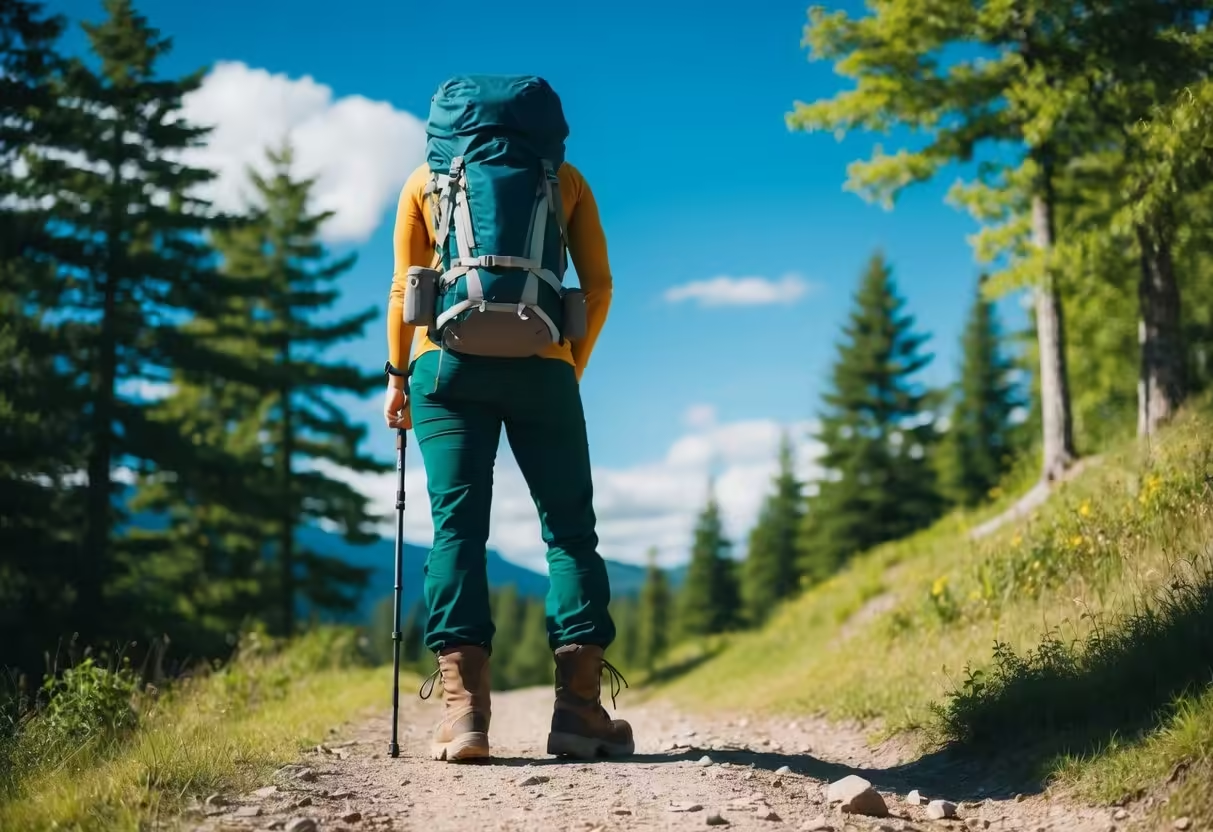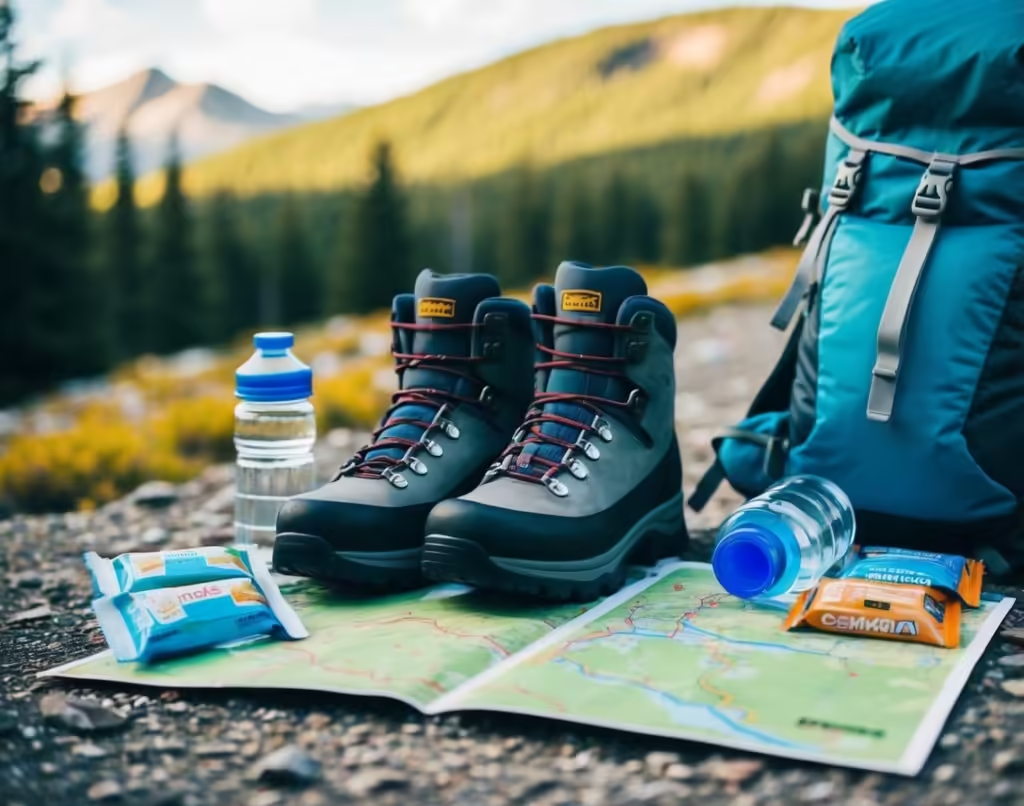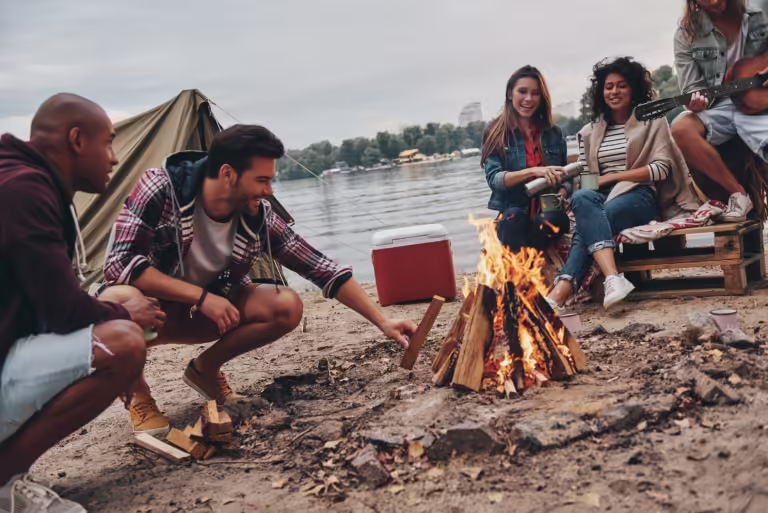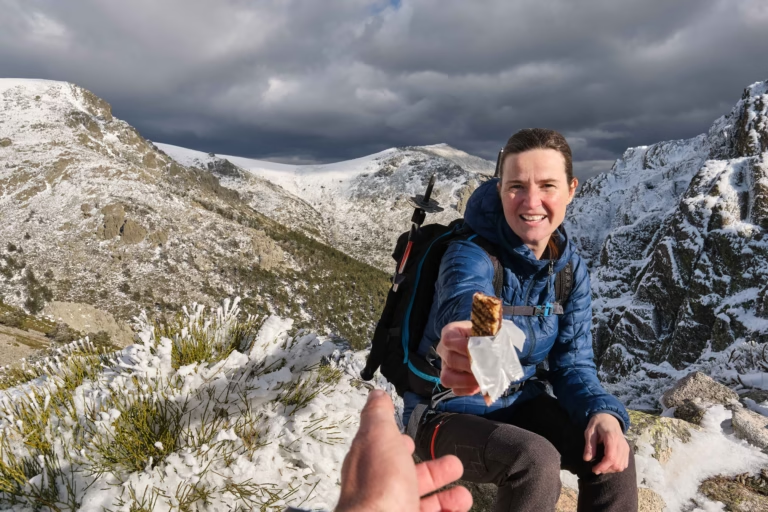Beginner Hiking Tips: Essential Guide for Your First Trail Adventure
Hiking is a great way to get outside and enjoy nature. It’s fun, healthy, and can be done by almost anyone. We love hiking and want to share some tips to help you get started.

New hikers should start with short, easy trails and bring plenty of water and snacks.
It’s best to pack about 200-300 calories of food per hour of hiking. For water, aim for about half a liter per hour. These amounts may change based on the weather and how hard the trail is.
We also suggest wearing good shoes and clothes that fit well. Bringing a map or guide of the trail is smart too. This way, you’ll know what to expect on your hike. Remember to tell someone where you’re going before you leave. With these tips, you’ll be ready for a fun and safe hike!
Key Takeaways
- Pick easy trails and bring enough food and water
- Wear good shoes and clothes that fit well
- Tell someone where you’re going before you hike
Table of Contents
Getting Started with Hiking
Hiking is a great way to enjoy nature and get some exercise. We’ll cover the basics, trail selection, proper clothing, and weather considerations to help you start your hiking journey safely and confidently.
Understanding the Basics of Hiking
Hiking is walking in nature on trails or paths. It’s a fun way to explore the outdoors and stay fit. As beginner hikers, we should start with short, easy hikes. This helps us build stamina and learn about hiking gear.
We need to bring water and snacks on our hikes. A good rule is to pack 0.5 liters of water for each hour we plan to hike. For food, 200-300 calories per hour is usually enough.
It’s important to let someone know where we’re going and when we’ll be back. This keeps us safe in case something happens on the trail.
Selecting Easy Hiking Trails
For our first hikes, we should choose beginner-friendly trails. These are usually well-marked and not too long or steep. We can find easy trails at local parks or nature reserves.
Before we go, we should read about the trail. This helps us know what to expect. We can look for:
- Trail length
- Elevation gain
- Estimated time to complete
- Trail conditions
- Points of interest
Many hiking websites and apps can help us find suitable trails near us. We can also ask at local outdoor stores for recommendations.
Dressing Appropriately for a Hike
Wearing the right clothes makes hiking more comfortable and safe. We should dress in layers so we can adjust to changing temperatures.
Here’s a basic hiking outfit:
- Base layer: moisture-wicking shirt
- Insulating layer: fleece or light jacket
- Outer layer: waterproof jacket (if rain is possible)
- Hiking pants or shorts
- Hiking socks: wool or synthetic, not cotton
- Sturdy hiking shoes or boots
We should avoid cotton clothes as they stay wet when we sweat. Synthetic or wool materials are better because they dry quickly.
The Importance of Checking Weather Conditions
Always check the weather before we go hiking. This helps us prepare and stay safe. We should look at:
- Temperature
- Chance of rain or snow
- Wind speed
- Sunset time
If the forecast shows bad weather, it’s better to reschedule our hike. We don’t want to get caught in a storm or extreme temperatures.
The weather can change quickly in some areas, especially in the mountains. We should be ready for different conditions and bring extra layers just in case.
Essential Hiking Gear for Beginners
Getting the right gear is key for a safe and fun hike. We’ll cover must-have items to keep you comfortable and prepared on the trail.
Choosing Appropriate Footwear
Good shoes are crucial for hiking. We recommend sturdy hiking boots or shoes with ankle support and grippy soles. Look for water-resistant options to keep your feet dry.
Try on different brands to find the best fit. Make sure there’s room for your toes and no heel slippage. Break in new boots before a long hike to avoid blisters.
For day hikes on easy trails, trail running shoes can work well too. They’re lighter and more flexible than boots.
Pair your footwear with moisture-wicking socks to prevent blisters and keep your feet comfy.
Packing the Right Backpack
A good hiking backpack makes carrying gear easier. For day hikes, a 20-30 liter pack is usually enough. Look for:
- Padded shoulder straps and hip belt
- Multiple compartments for organizing gear
- Water bottle pockets
- Breathable back panel
Pack smart by putting heavy items close to your back and lighter stuff on top or in outer pockets. Don’t forget to bring plenty of water and snacks.
A pack cover can keep your gear dry if it rains. Some backpacks have built-in rain covers.
Navigation Tools for Safe Exploring
Even on well-marked trails, it’s smart to bring navigation tools. Here’s what we suggest:
- Map of the area (waterproof is best)
- Compass
- GPS device or smartphone app
Learn basic map and compass skills before your hike. Don’t rely solely on your phone, as batteries can die or you might lose signal.
Consider downloading offline maps to your phone as a backup. Some popular hiking apps let you do this for free.
A watch can also be helpful for tracking your hiking time and planning your return.
Emergency and Safety Equipment
Being prepared for emergencies is vital. Here are some key items to pack:
- First-aid kit: Include bandages, pain relievers, and any personal medications
- Headlamp or flashlight: In case your hike takes longer than expected
- Emergency shelter: A light tarp or emergency blanket can provide protection
- Repair kit: Multi-tool, duct tape, and zip ties for quick fixes
- Fire starter: Waterproof matches or a lighter
- Whistle: For signaling for help
For longer or more remote hikes, consider a satellite communicator for emergency calls outside cell range.
Always tell someone your hiking plans before you go. Bring more food and water than you think you’ll need, just in case.
Planning Your Hike
Getting ready for a hike takes some prep work. We’ll cover how to read trail info, figure out tough spots, and use helpful apps. These skills will make your hike safer and more fun.
Learning to Read Trail Markings and Difficulty Ratings
Trail markers and ratings can be tricky at first. Most hiking trails use colors or symbols to show the way. Look for these on trees, rocks, or posts.
Difficulty ratings usually go from easy to hard. Easy trails are flat and short. Hard ones are steep or long. Moderate hikes fall in between.
Pay attention to trail conditions too. Recent rain can make paths muddy. Fallen trees might block the way. Check recent hiker reports before you go.
Estimating Elevation Gain and Terrain Challenges
Elevation gain tells us how much climbing we’ll do. A flat walk has little gain. A mountain climb has lots.
We measure gain in feet or meters. 1,000 feet of gain is a good workout for beginners. More than that can be tough.
Terrain matters too. Rocky paths are harder than smooth ones. Steep sections take more energy. Look at trail guides to learn what to expect.
• Flat terrain: Easy
• Rolling hills: Moderate
• Steep climbs: Hard
• Rocky paths: Challenging
Utilizing Hiking and Nature Apps
Hiking apps are super helpful. They can show us maps, track our hike, and more. Here are some popular ones:
- AllTrails: Great for finding and following trails
- Gaia GPS: Detailed maps and offline use
- PeakFinder: Identifies mountain peaks around you
- iNaturalist: Helps identify plants and animals
These apps can guide us on the trail. They also let us share our hikes with friends. Some even work without cell service.
We can use them to check trail conditions and difficulty. They often have user reviews too. This helps us know what to expect.
Trail Etiquette and Leave No Trace Principles
Good trail manners and caring for nature are key parts of hiking. We’ll look at how to share trails nicely and keep nature safe.
Respecting the Right of Way on Trails
When we hike, it’s important to know who goes first on the trail. Hikers going uphill have the right of way. If we’re going down, we should step aside to let them pass. This helps them keep their pace.
We also need to watch out for others. Bikers should yield to hikers. And we all should make way for horses.
When hiking in groups, we should stay in a single file. This lets others pass easily. It’s polite to say hello to other hikers too!
Staying on Trails and Preserving Nature
Leave No Trace principles guide us in taking care of nature. We should always stick to marked trails. This protects plants and prevents erosion.
We must pack out what we bring in. This means taking all our trash with us, even fruit peels. They don’t belong in nature.
It’s fun to see animals, but we shouldn’t feed them. Human food can make them sick. We should also keep our distance to avoid scaring them.
When we camp, we should use existing sites. This reduces our impact on the land. We should also be careful with fires and follow local rules.
Health and Safety While Hiking

Staying safe and healthy on the trails is key to having a great hiking experience. We’ll cover some important tips to help you stay in top shape during your outdoor adventures.
Staying Hydrated and Nutrition on the Trails
Proper hydration is crucial when hiking. We always bring extra water to avoid running out. A good rule of thumb is to drink about half a liter per hour of hiking.
Don’t forget to pack nutritious hiking snacks too. Energy bars, trail mix, and fruits are great options. We aim for 200-300 calories per hour of hiking to keep our energy up.
Here’s a quick list of snack ideas:
- Mixed nuts and dried fruit
- Jerky or meat sticks
- Peanut butter sandwiches
- Granola bars
Remember to pack a bit extra food in case your hike takes longer than expected.
Understanding Your Physical Abilities and Limitations
It’s important to be honest about our fitness level when choosing a hike. We start with shorter, easier trails and gradually work up to more challenging ones.
Listen to your body during the hike. If you feel tired or sore, take a break. It’s okay to turn back if the trail becomes too difficult.
Before hitting the trails, we do some simple exercises to prepare:
- Squats
- Lunges
- Calf raises
- Light cardio
These help build the muscles we use most while hiking.
Hiking with Company vs. Hiking Alone
Hiking with a buddy is often safer, especially for beginners. A partner can help if you get hurt or lost.
If you do hike alone, always tell someone where you’re going and when you’ll be back. Bring a fully charged phone and a portable charger.
Some benefits of hiking with others:
- Shared experience and fun
- Extra help in emergencies
- Motivation to keep going
Solo hiking can be peaceful, but it’s best for experienced hikers on familiar trails.
Hiking with a dog is also a great way to bond with your pup and they make pretty great company.
Sun Protection and Dealing with Weather Changes
The sun can be intense on the trails, even on cloudy days. We always wear sunscreen, sunglasses, and a hat for protection.
Weather can change quickly, so we pack extra clothes just in case. A light rain jacket and a warm layer are must-haves.
Our sun protection checklist:
- SPF 30+ sunscreen
- UV-blocking sunglasses
- Wide-brimmed hat
- Long-sleeved shirt (for extra coverage)
We check the weather forecast before heading out. If there’s a chance of storms, we reschedule or choose a shorter trail.
Advanced Preparations for Longer Hikes

Getting ready for a long hike takes some extra planning. We’ll look at key things to pack and safety tips for different types of extended treks.
Preparing for Day Hikes vs. Backpacking Trips
Day hikes and backpacking trips need different gear. For day hikes, we can pack light. A small backpack with water, snacks, and a first-aid kit is often enough.
Backpacking trips need more stuff. We’ll want a bigger pack, tent, sleeping bag, and cooking gear. Food planning is key too. We should pack lightweight, high-energy foods that won’t spoil.
For long-distance hikes like the Appalachian Trail, we might need 70-80 liter packs. These big packs let us carry enough for many days on the trail.
Packing Considerations for Extended Treks
On long hikes, every ounce counts. We should pick gear that’s light but tough.
Here’s a quick list of must-haves:
- Lightweight tent
- Compact sleeping bag
- Portable stove
- Water filter
- Map and compass
Clothes are important too. We should pack layers to deal with changing weather. Quick-dry fabrics are best.
Food takes planning. We can save weight by dehydrating meals at home. Energy bars and dried fruits are good trail snacks.
Safety Measures for Mountain and Wilderness Hiking
Safety is key in the wild. We should always tell someone our plans before we go.
A good first-aid kit is a must. We should know how to use everything in it.
For mountain hikes, we might need extra gear:
- Trekking poles for balance
- Crampons for icy spots
- Emergency shelter
Weather can change fast in the mountains. We should check forecasts and be ready to turn back if needed.
It’s smart to build up to longer hikes. We can start with short trips and slowly go further. This helps our body get used to long days on the trail.
Frequently Asked Questions
New hikers often have many questions before hitting the trail. We’ll cover the basics of getting started, what to bring, common mistakes to avoid, and important etiquette tips.
How do beginners start hiking?
Starting hiking is easy. Pick an easy trail near you. Wear comfortable shoes and clothes. Bring water and snacks. Tell someone where you’re going. Go with a friend if possible. Start with short hikes and work your way up to longer ones.
What should I bring on a basic hiking trip?
For a basic hike, pack water, snacks, a map, and a first-aid kit. Wear layers of clothing. Bring sun protection like a hat and sunscreen. Don’t forget insect repellent. A multi-tool or knife can be handy. Pack a trash bag to carry out any litter.
What are the most common mistakes first-time hikers make?
New hikers often make a few key mistakes. They don’t bring enough water. They wear the wrong shoes or new boots. They don’t check the weather. Some try trails that are too hard. Others don’t tell anyone where they’re going. Avoiding these errors makes hiking safer and more fun.
Can you start hiking if you’re not in shape, and how?
Yes, anyone can start hiking! Begin with short, easy trails. Take breaks when you need to. Gradually increase distance and difficulty as you get stronger. Drink plenty of water. Listen to your body and don’t push too hard. Consistency is key – hike regularly to build stamina.
What is the #1 etiquette rule while hiking?
The top rule is to follow Leave No Trace principles. This means packing out all trash, staying on marked trails, and not disturbing nature. Be respectful of wildlife and other hikers. Keep noise levels down. Yield to uphill hikers. If you’re hiking with a dog keep them leashed and don’t allow them to bother other hikers. These practices help preserve nature for everyone.
What’s a good length for a beginner’s hike?
For beginners, a good hike is 3-5 miles. This usually takes 2-3 hours. Start with shorter hikes if you’re new to exercise. As you get more comfortable, you can try longer trails. Remember, it’s not just about distance. Consider the terrain and elevation changes too. Always choose a trail that matches your fitness level.








